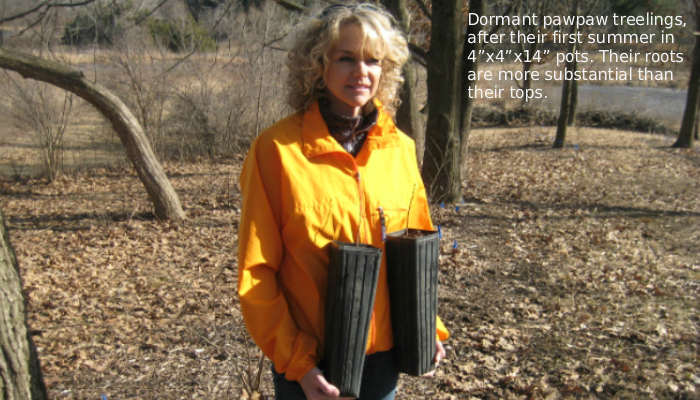Growing Pawpaw Trees from Seed

Last summer, before the brief pawpaw season arrived, I posted a blog on how to save seed to grow your own trees. If you now have some seed that didn’t dry out, my preferred method for starting trees follows:
Around March 15, fill one large deep flowerpot or small tub with commercial potting soil, which is just crumbled peat with a sprinkle of slow-release fertilizer, and plant all the seeds in it, an inch deep and an inch or two apart. Hold at room temperature (full sunshine not necessary), and water enough just to keep the soil damp. Germination is slow and erratic, but at room temperature some should begin popping up by May 15. By then we are normally past last frost and new seedlings can be transplanted to their individual pots and taken directly outdoors, with no need for a sunny bay window, indoor grow-lights, or a greenhouse.
When young, pawpaw is strongly tap-rooted, and by the time you see the sprouts up an inch or two, the roots are 4-5 inches long. The seed shell might still be on top the stem, enclosing the folded leaves. Just leave it alone and the unfurling leaves will push it off.
Once the first few leaves open, it is time to transplant the seedlings to their own individual deep pots. I prefer commercial 4”x4”x14” ones, but you might also adapt tall milk cartons, clay farm tiles, or pieces of PVC pipe, with good drainage, and preferably small holes in the sides for oxygen exchange. It is important to use real dirt in these pots, not potting soil, because come autumn you want the whole prism of soil to come out as a single unit and not crumble. I fill my pots weeks in advance of transplanting the bareroot trees in, and water several times to get the dirt settled.
So as your indoor seedlings start leafing out, transplant them to the prepared tall pots. Take the time to get the long roots aimed down into the new pot. Move them outdoors to some convenient location in the yard that gets light shade, especially between 12:00 and 2:00. Water as needed. Full sun their first year will kill or stunt them, yet in later years they are at their best in full sun or only light shade. Milk crates are handy for holding these tall, skinny pots upright.
When these young plants go dormant and lose their leaves in autumn, they will be nearly a foot tall and it will be time to transplant to their permanent location. Being native to our original forests, they are tolerant of nearby black walnut trees. The more competition pawpaw has, the more inclined it is to form a thicket to intercept more light. Also, they definitely need a sheltered microclimate, see my blogs regarding local microclimates: Microclimates are Important to Planting in Southeast Iowa, Microclimates II: How Do They Affect Animals? Microclimates III: How To Recognize Them In The Field
So in mid to late October, let their soil dry out a bit to form a delicate brick, carefully extract it intactfrom the pot (I slit the thin commercial pots lengthwise), trim off any roots coiled in the bottom, and plant. Mulch lightly and water well. Bunnies won’t eat them, but will sometimes nip off the skinny treelings, so for their first winter I slip a 15” length of PVC pipe over them, taped onto a stake for support. If it grows slowly the next summer, I can sometimes bend the branches enough to repeat the winter protection.


